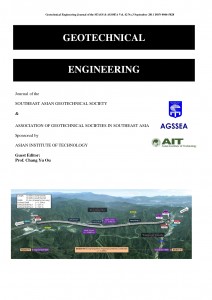Building Damage Assessment for Deep Excavations in Singapore and the Influence of Building Stiffness
Main Article Content
Abstract
One of the biggest issues for underground construction in a densely built-up urban environment is the potentially adverse impact on buildings adjacent to deep excavations. In Singapore, a building damage assessment is usually carried out using a three-staged approach to assess the risk of damage caused by major underground construction projects. However, the tensile strains used for assessing the risk of building damage are often derived using deflection ratios and horizontal strains under ‘greenfield’ conditions. This ignores the effects of building stiffness and in many cases may be conservative. This paper presents some findings from a study on the response of buildings to deep excavations. Firstly, the paper discusses the settlement response of an actual building – the Singapore Art Museum – adjacent to a deep excavation. By comparing the monitored building settlement with the adjacent ground settlement markers, the influence of building stiffness in modifying the response to excavation-induced settlements is observed. Using the finite element method, a numerical study on the building response to movements induced by deep excavations found a consistent relationship between the building modification factor and a newly defined relative bending stiffness of the building. This relationship can be used as a design guidance to estimate the deflection ratio in a building from the greenfield condition. By comparing the case study results with the design guidance developed from finite element analysis, this paper presents some important characteristics of the influence of building stiffness on building damages for deep excavations.
Article Details

This work is licensed under a Creative Commons Attribution-NonCommercial-NoDerivatives 4.0 International License.
Copyright © 2019 Association of Geotechnical Societies in Southeast Asia (AGSSEA) - Southeast Asian Geotechnical Society (SEAGS).


